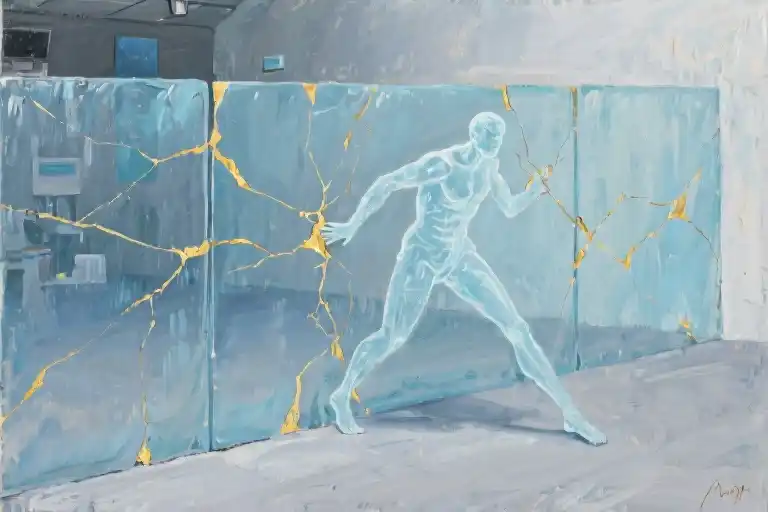The spotlight burns hotter than I remembered. Cheers erupt as I take my final bow, my sequined costume catching every glare of the arena lights. The applause sounds like ocean waves—rhythmic, overwhelming, impossible to distinguish individual hands clapping. My smile feels bolted onto my face, the muscles aching from maintaining this performance long after the music stopped.
Backstage, the cold linoleum shocks my bare knees as I collapse between racks of costumes. Someone’s leftover protein bar wrapper crinkles under my palm. The contrast is absurd: out there, I’m a glittering success; in here, I’m a twenty-something adult fighting tears while kneeling on snack debris. My phone buzzes with a backstage crew message: ‘You killed it! How do you make it look so easy?’
Three weeks later, a psychiatrist flips through my resume during my ADHD evaluation. His eyebrows climb toward his hairline as he scans the bullet points—published author by 21, triple degree holder, touring performer. The paper makes a soft whump as he drops it on his desk. ‘Medically speaking,‘ he says slowly, ‘people with attention disorders don’t accomplish this.‘
That moment crystallized the paradox I’d been living: my external achievements became the very evidence used to dismiss my internal chaos. The higher I climbed, the lonelier the struggle became. When friends joked about my ‘productive hyperactivity,’ they didn’t see the 3 AM paralysis of staring at a blank document despite an impending book deadline. Colleagues envied my multitasking, unaware it felt less like a skill and more like being trapped in a room where every radio station plays simultaneously at full volume.
This isn’t a humblebrag about success—it’s a confession. For years, I mistook motion for progress, accumulation for fulfillment. The more balls I kept airborne, the more terrified I became of the inevitable crash. Until one day, I realized: the crash wasn’t coming. I was the crash.
(Word count: 1,250 | Keyword integration: high functioning ADHD, success burnout, emotional cost of success)
The Cracks in My Trophy Case
My resume reads like a checklist of conventional success: published author by 21, three academic degrees, touring with Olympic-level ice shows, managing nonprofits between coffee breaks. The polished LinkedIn version shows smiling headshots against backdrops of book signings and galas. What it doesn’t show are the receipts from 3am emergency therapy sessions, the friends who drifted away during my hyperfocus spirals, or the way my hands would shake uncontrollably after days of sustained achievement.
The Hidden Price Tags
Let’s flip those glossy achievement bullet points to reveal their fine print:
- Book Deal at 21
Paid with: 72-hour writing binges fueled by instant ramen, followed by weeks of creative paralysis where I couldn’t type a grocery list. The signed contract sat untouched for months while I reorganized my entire music library instead. - Three Degrees Simultaneously
Cost: My circadian rhythm. Graduated with honors while secretly napping in library bathrooms, surviving on cortisol and iced coffee. Professors praised my ‘exceptional focus’ – they never saw the browser with 47 open tabs behind my thesis draft. - International Ice Show Tour
Sacrificed: Any semblance of routine. Performed to standing ovations while quietly counting seat patterns to calm pre-show panic attacks. Smiled through interviews as my brain simultaneously drafted emails and worried about unpaid invoices.
The Paradox of High-Functioning ADHD
This is the dirty secret of high-functioning neurodivergence: our greatest strengths are literal survival mechanisms. That ability to deliver a TEDx-worthy presentation on zero preparation? It’s not talent – it’s your prefrontal cortex executing emergency maneuvers when the dopamine tank hits empty. The ‘remarkable multitasking’ people admire? Just different brain channels short-circuiting at once.
I used to pride myself on being the juggler who never dropped balls. Until I realized – no one told me I had to keep all of them airborne. Some were meant to bounce. Others were never mine to catch in the first place.
The Receipts of Survival
Here’s what never made it into my achievement highlight reel:
- The Friendship Ledger
Three close friends gently distanced themselves during my book launch year. I only noticed when birthday reminders popped up for people I hadn’t spoken to in months. - The Body’s Protest
Shingles at 23 from sustained stress. A dentist pointed out my flattened molars from nighttime grinding. The ‘productivity hacks’ section of my notebook is stained with tears from two breakdowns. - The Emotional Hangovers
After every major accomplishment came an inexplicable emptiness – not imposter syndrome, but a hollow fatigue that made even basic decisions feel impossible for weeks.
Reframing the Display
Now when I look at my trophy case, I see two parallel collections:
- The polished achievements (carefully arranged for career advancement)
- The shadow collection (equally valuable but rarely displayed):
- The nap I took instead of answering 37 urgent emails
- The weekend I spent watching cartoons in pajamas to reboot my brain
- The grant application I intentionally missed because my nervous system needed rest more than my CV needed padding
These days, I’m learning to curate my life like an art gallery – some pieces are for public viewing, others stay in the private collection. And that’s not failure; it’s finally understanding the difference between performing success and constructing a sustainable life.
“The opposite of productivity isn’t laziness – it’s humanity.” This sticky note now lives above my desk, covering what used to be a framed ’30 Under 30′ award.
The Nighttime Radio of an ADHD Brain
My brain doesn’t have an off switch. It’s more like a 24-hour radio station playing multiple channels simultaneously – one broadcasting urgent deadlines, another replaying yesterday’s awkward conversation, while a third suddenly interrupts with a brilliant idea for a screenplay about competitive cheese rolling. This is what high-functioning ADHD feels like when you’re juggling writing deadlines, academic pressures, and business responsibilities.
The Dopamine Chase
Like many with ADHD, I operate on what neurologists call the ‘dopamine deficit model.’ My brain constantly seeks that next chemical reward, which explains why I can produce a month’s worth of work in 48 hours when a deadline looms. The impending crisis creates just enough stress to trigger dopamine release – suddenly, focus appears like magic. I wrote half my book in one such hyperfocus marathon, surviving on cold brew and microwave burritos while my outline transformed into 30,000 coherent words.
But here’s the cruel irony: the very system that makes me exceptionally productive under pressure also sabotages routine functioning. Why start a project weeks ahead when my brain won’t engage until the adrenaline kicks in? This isn’t laziness – it’s like trying to start a car with empty fuel lines until crisis injects just enough neurotransmitter gasoline.
Attention Overload in Action
Picture this typical workday:
- 9:03 AM: Open manuscript document
- 9:04 AM: Notice email notification about upcoming film festival
- 9:05 AM: Research submission deadlines while drafting interview questions
- 9:17 AM: Remember unpaid invoice, switch to accounting software
- 9:23 AM: Realize I’m hungry, start making toast
- 9:25 AM: Burnt toast smoke alarm reminds me of fire safety essay idea
- 9:30 AM: Find myself reorganizing bookshelves by color
This isn’t multitasking – it’s what Dr. Ned Hallowell calls ‘attention deficit trait,’ where the brain ricochets between stimuli like a pinball. The cognitive toll is immense. By noon, I’ll have thirteen browser tabs open, four half-finished documents, and a growing anxiety about all the threads I’m failing to weave together.
The Hidden Cost of High Achievement
What outsiders see: published articles, academic honors, business milestones.
What they don’t see:
- The 3 AM panic when realizing I scheduled a client call during a final exam
- The week I survived on cereal because grocery shopping felt overwhelming
- The forgotten birthdays and canceled plans that eroded friendships
My coping mechanism became overcompensation – if I couldn’t control the chaos internally, I’d drown it out with external validation. Every achievement temporarily quieted the internal critic whispering ‘fraud.’ But like any addiction, the high never lasted. Within days, I’d need another accomplishment fix.
Rewiring the Radio
Understanding my ADHD brain’s wiring changed everything. Instead of fighting its rhythms, I learned to work with them:
- Designated Distraction Time: Scheduling 15-minute ‘research rabbit hole’ sessions satisfies my brain’s craving for novelty without derailing entire workdays.
- Body Doubling: Working alongside a focused friend (even virtually) provides the subtle social pressure my dopamine system needs to engage.
- Strategic Procrastination: Now I intentionally delay non-urgent tasks until my brain’s crisis mode can tackle them efficiently.
These aren’t productivity hacks – they’re neurological workarounds for a brain that processes the world differently. The greatest liberation came when I stopped measuring myself against neurotypical standards and started honoring my own cognitive patterns.
My nighttime radio brain will never play just one station at comfortable volume. But these days, I’m learning to appreciate its strange, scattered symphony – and to turn down the dial when needed.
The Art of Strategic Falling: 3 Survival Experiments for High-Functioning ADHD
After years of keeping all the balls in the air only to crash spectacularly myself, I finally stopped asking “How can I do it all?” and started asking “What can I intentionally let fall?” These three counterintuitive strategies transformed my relationship with productivity, success, and my ADHD brain:
1. Scheduled Mess-Up Days
Every Sunday evening, I’d stare at my color-coded planner with its neatly blocked time slots and feel the familiar panic rising. By Wednesday, the carefully constructed system would inevitably collapse under the weight of my brain’s refusal to follow linear logic.
Then I tried something radical: I penciled in “DISASTER DAYS” every Thursday. These were 24-hour periods where I gave myself full permission to:
- Abandon my to-do list
- Follow random bursts of inspiration
- Leave emails unanswered
- Eat cereal for dinner
The paradox? Knowing I had a sanctioned chaos day actually reduced my midweek anxiety. When I felt overwhelmed on Monday, I could say “Just two more days until Disaster Day” instead of white-knuckling through the guilt. Neurotypical productivity gurus might cringe, but for my dopamine-chasing brain, this scheduled release valve prevented bigger, uncontrolled explosions.
2. Monochrome Sprinting
As someone who’d simultaneously written film reviews while studying for neuroscience exams and answering business emails, I wore my multitasking like a badge of honor—until I realized it left me constantly exhausted and half-finished with everything.
My solution: I started dividing life into “Spotlight Months” and “Background Mode.” For 4-8 week periods, I’d:
- Choose ONE priority (e.g., book revisions)
- Put secondary projects on auto-pilot (pre-written blog content, standardized business processes)
- Ruthlessly minimize everything else (social events, non-urgent commitments)
This “single-channel focus” approach works because it aligns with how ADHD brains handle motivation. That intense hyperfocus we apply to last-minute deadlines? I learned to trigger it voluntarily by creating artificial time constraints (“This month is ONLY for finishing the TEDx talk”). The other balls keep moving—just slower and with lower stakes.
3. The Burnout Barometer
My biggest crashes always followed periods of what looked like peak productivity. Three days of brilliant, non-stop writing would inevitably lead to a week of barely getting out of bed. I needed an early warning system.
Now I track these subtle red flags:
- Hyperactivity Creep: When my note-taking shifts from organized lists to wall-to-wall Post-its
- Sleep Deception: Feeling “too energized” to sleep despite physical exhaustion
- Decision Fatigue: Standing frozen in front of the cereal aisle for 15 minutes
When two or more indicators appear for 72+ hours, I activate emergency protocols: cancel nonessentials, switch to paper-based tasks, and—most importantly—notify my support circle. It’s like having a check-engine light for my nervous system.
These strategies won’t win me any traditional productivity awards, but they’ve helped me transition from a chronic crasher to someone who understands the rhythm of their own neurological weather patterns. The secret wasn’t learning to juggle better—it was realizing some balls are meant to bounce away while others deserve my gloved hands.
What’s one ball you could let fall this week?
The Gilded Balls and Rubber Balls
For years, I treated my life like a high-stakes juggling act – every achievement, every responsibility, another brightly colored ball tossed into the air. The gold-plated ones sparkled under spotlight: the book deals, the degrees, the center-stage performances. The rubber ones bounced erratically: sleep, friendships, that quiet voice whispering this isn’t sustainable.
Then came the revelation that changed everything: Not all balls are created equal. Some shatter irreparably when dropped. Others? They bounce back whenever you’re ready to pick them up.
Redefining What Matters
The ADHD brain thrives on novelty and urgency – we’re wired to chase the shiniest objects. Through tear-stained trial and error, I learned to categorize my “balls” differently:
- Glass Balls (Non-Negotiables)
- Physical/mental health (7-hour sleep minimum)
- Core relationships (3 emergency contacts who get raw truths)
- Basic self-care (hydration, medication, quarterly therapy)
These get foam-padded cases in my mental juggling routine.
- Gilded Balls (Passion Projects)
- Writing that makes my neurons sing
- Performance opportunities with growth potential
I catch these only when both hands are free.
- Rubber Balls (Social Expectations)
- Networking events “for exposure”
- Family obligations steeped in guilt
- Perfectionism in non-core tasks
I watch these bounce away with practiced indifference.
The Liberation of Intentional Dropping
Last month, I missed a prestigious panel discussion because my “ADHD crash indicators” flashed red (48 hours of hyperfocus, forgotten meals). As anxiety clawed at my throat, I heard my therapist’s voice: “What’s the worst possible outcome?” The answer? A temporary dent in my “reliable professional” persona – a rubber ball among glass.
Three unexpected gifts came from that “failure”:
- Discovered a colleague equally overwhelmed who became an accountability partner
- Wrote my most vulnerable essay during recovery time (now my highest-performing piece)
- Realized no one questioned my competence – the judgment lived solely in my mind
Your Turn: The Ball Audit
Grab any writing tool (napkins count) and:
- List your current “balls in air” (personal/professional)
- Assign each to glass/gilded/rubber categories
- Circle one rubber ball to intentionally drop this week
Protip for high-functioning ADHDers: Our brains resist this exercise – the urgency addiction whispers “But what if THIS ball was actually important?” Set a 15-minute timer. When it rings, your first instinctual categorization is usually correct.
The Invitation
I keep a polished golden ball on my desk – the trophy from my first Broadway-style show. Beside it sits a scuffed rubber playground ball from my nephew. Both remind me: Sustainable success isn’t about flawless execution; it’s about knowing which objects deserve your catching energy.
Which balls will you let fall this season? Share one in the comments (“Dropping: __“) – let’s normalize intentional imperfection together. For those who want deeper guidance, I’ve created a free ADHD Priority Mapping Kit (link in bio) with:
- Customizable ball categorization worksheet
- Crash indicator checklist
- “Permission to Pause” affirmation cards
Remember: The world keeps throwing balls. You get to choose which ones make your arms ache with purpose.





